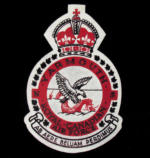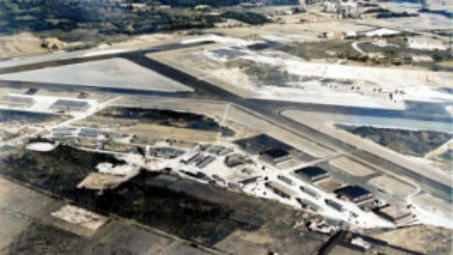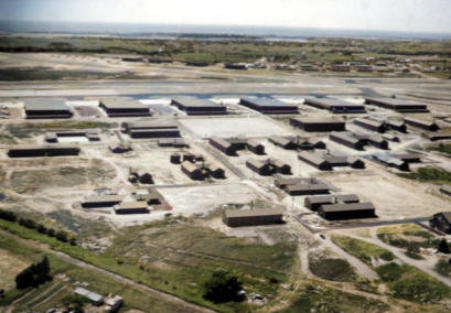Wartime Heritage
ASSOCIATION

RCAF Station Yarmouth, Nova Scotia
(From the Air to Destroy
the Beast)
The base was known as RCAF Station Yarmouth during World War II. Land for the main runway, from Starr’s Road south west past
Forest Street, through to Argyle Street had been purchased as early as 1939. Clearing of land began shortly after purchase and the
construction of the airport continued up to 1942 when the last two hangars were completed.
West Camp was located nearest to the town on the west side
of the airport and was a Royal Canadian Air Force airbase
established for anti-Submarine Bomber Reconnaissance
squadrons.
East Camp was a training base for the British Commonwealth
Air Training Plan (BCATP). East Camp Had two air units
during its operation. Royal Air Force #34 Operational Training
Unit (OTU) trained air crews for Bomber Command
operations in Europe. Later the Royal Navy at its #1 Naval Air
Gunners School, with cooperation of the Royal Canadian Air
Force trained Telegraphist Air Gunners for duties with the
Fleet Air Arm in every theatre of war, world wide, in WWII.
In the summer of 1945, with the end of the war in Europe,
two squadrons of the RCAF #6 Bomber Group arrived at RCAF
Yarmouth, one to West Camp and one to East Camp, flying
Avro Lancaster bomber aircraft. They were to train for the
Far East Pacific Campaign; however, the war ended when the
“A’ bomb was dropped and the squadrons were disbanded.
The RCAF Station Yarmouth Airbase
RCAF Station Yarmouth was manned and operated by Air Force personnel not attached to the squadrons. The workforce ran the day-
to-day operations of the station from both East and West Camp Headquarters and kept personnel records for all Airmen and
Airwomen on the base.
RCAF Administration was also responsible for the weekly pay for the Army, Navy, and Air Force Camp personnel.
RCAF personnel were in charge of messing at six different messes with meals for several thousands of people every day.
The Motor Pool supplied numerous vehicles for the base and squadrons to operate. These included personnel cars, light trucks,
jeeps, patrol trucks, ammunition carriers, fire trucks, snow ploughs, and all the necessary personnel to operate them.
The Camps were complete with paved named roads, sewers, water, and streetlights. All the buildings in the base were heated by
steam, supplied underground through a network of pipes. A large maintenance department kept all buildings, roads, and runways in
repair.
The Supply Departments of both camps were huge and supplies for the Base came in by rail, mostly unloaded in the Town of
Yarmouth and taken by air force trucks to the Camps.
The Station operated the Hospital and a full medical staff of doctors, surgeons, and nurses. The Dental Clinic, fully equipped, had
three dental officers on staff.
Two special units of Military Police, the RCAF and Royal Navy, were in charge of discipline and security.
Weather information and the control tower, operating 24 hours a day.
RCAF Station Yarmouth was made-up of two complete little cities, each working hard to keep hundreds of air crew, and many kinds
of aircraft flying year round, at all times, and in all kinds of weather.

copyright © Wartime Heritage Association
Website hosting courtesy of Register.com - a web.com company
RCAF Station Yarmouth


West Camp
East Camp
Also see:
RCAF Station Yarmouth (West Camp)
RCAF Station Yarmouth (East Camp) - Telegraphist Air Gunners
Telegraphist Air Gunners - Menu of Articles and Photo
RCAF Station Yarmouth Crashes 1941 - 1944
The Planes of RCAF Station Yarmouth
119 Squadron - RCAF Station, Yarmouth NS (WWII)
Casualties of RCAF Station Yarmouth
The Pacific War Ends August 14, 1945
Crash of Vega Ventura AE 932 - November 20, 1942



- World War I - Menu
- WWI Stories and Articles
- Photos - Yarmouth Soldiers
- Selection of World War I Songs
- WWI Casualties of Yarmouth, NS
- Those Who Served - Yarmouth, NS
- WWI Casualties Digby Co. NS
- WWI Casualties Shelburne Co. NS
- Merchant Mariners (1915) Yarmouth, NS
- Canadian Forestry Corps - Non Yarmouth Birth/Residence Enlistments
- US Draft Registry - Yarmouth NS Born


- World War II - Menu
- WWII Stories and Articles
- Telegraphist Air Gunners
- WWII Casualties of Nova Scotia
- US Casualties with NS Connection
- Far East/Pacific Casualties with NS Connection
- Merchant Navy Casualties Nova Scotia
- Nova Scotia WWII Casualties Holten Canadian War Cemetery
- D-Day Casualties - Nova Scotia
- CANLOAN Program Casualties - Nova Scotia
- Battle of the Bulge Casualties - Nova Scotia
- WWII Casualties Yarmouth NS
- Yarmouth Casualties - RCAF RAF Canadian Army WWII
- Yarmouth Co., Marrages WWII
- Casualties Non-Born/Residents with Connection to Yarmouth Co., Nova Scotia.
- WWII Casualties Digby Co., NS
- Non-Nova Scotian WWII Casualties Buried in Nova Scotia
- WWII RCAF Casualties Aged 16-18
- Brothers/Sisters Who Served - World War II













